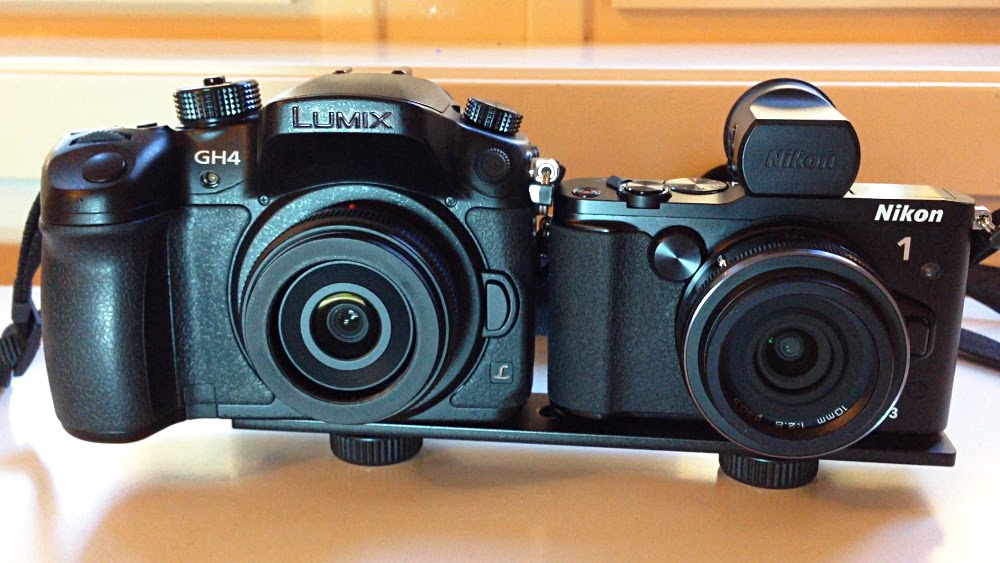Also, both cameras have some specific technology aimed to improve what has been the achilles' heel of mirrorless cameras so far: The autofocus performance during video recording, and for moving subjects.
Traditionally, mirrorless cameras have set the focus by adjusting the focal distance back and forth until the image becomes the most contrasty, i.e., Contrast Detection Autofocus (CDAF). This means that the camera does not know if the correct focus if to the front, or to the back of the current focus distance, and may need to guess which way to start moving the focus. This can be quite annoying during video recording, as you would see the focus jog back and forth during the footage.
The Lumix GH4 aims to fix this through DFD technology, Depth From Defocus. This means that the camera is loaded with lens profiles, and knows the characteristics of the out of focus rendering (bokeh) for all the Panasonic lenses. Using this data, it should do a better job at guessing which way to start moving the focus, and how far.
The Nikon 1 V3, on the other hand, is using on-chip PDAF sensors. Essentially, this means replacing some of the ordinary light sensitive sensors with sensors that can "see" if the image is out of focus, and also in which direction, and how far. The aim is the same: To more quickly be able to set the correct focus, especially for moving objects.
In a previous article, I compared the Nikon 1 J1 with the Lumix GM1 in terms of autofocus. I found that the older Nikon 1 J1 won by a considerable margin, due to the PDAF. But then again, the Lumix GM1 does not implement the DFD technology, so let's see if the GH4 makes a difference.
In this article, I am comparing the GH4 with the V3, both using similar pancake wide angle lenses. The GH4 is mounted with the Lumix 14mm f/2.5, and the V3 is using the Nikon 1 10mm f/2.8. As the Nikon 1 system has a larger crop factor, both these lenses correspond to approximately 28mm in equivalent terms, i.e., a traditional wide angle lens.
In the test, I set the Lumix lens to f/4, while leaving the Nikon lens at f/2.8, so that they both have about the same Depth of Focus (DoF). A smaller sensor (the Nikon camera) leads to a deeper DoF. I used the base ISO, except where I noted ISO 1600 in the video. Both cameras were set to 1080p full HD video, and 60 frames per second.
Both cameras were mounted to a Desmond Mini Dual Camera Bracket, typically used for stereo photography.
Here are the results:
Based on the results I saw with the Lumix GM1, I was expecting to find that the Nikon camera completely outclassed the GH4. However, it appears that the Panasonic DFD technology does have some merit. The Nikon 1 V3 is generally the fastest to achieve the right focus, but the difference is not huge anymore. Also, there was one case where the Nikon camera struggled, at a close distance in low light.
Panasonic have stated that they do not want to venture into PDAF for the sake of improving the autofocus speed. They are worried that replacing the sensor pixels with PDAF sensors will deteriorate the image quality, especially for 4k video.
Panasonic say that CDAF, combined with better and faster image processing, will be just as good. And perhaps they are right: We see here that they have come a long way. Keep in mind that this test was done with 1080p HD video, though. In 4k mode, the GH4 autofocus is very slow, see my test here.
Nikon appeares to have gotten the PDAF implementation right from the start. In my previous test I found that the Nikon 1 J1 had a very impressive performance, despite being a first generation product, and the cheapest model, too.
I also note that the Nikon 1 V3 appears to have slightly less rolling shutter effect. I would attribute this to the smaller sensor size, and the faster image scanning. The Nikon 1 cameras are known for having a very fast scanning electronic shutter, making the mechanical shutter largely unneeded.
This is in contrast to Micro Four Thirds cameras. I've measured the electronic shutter of the GH4 to be scanning the picture in about 1/30s, but it is still way slower than the approximate 1/80s scan of the Nikon 1 cameras.

interesting comparison particularly as I'm considering a switch from NX1 to GX80. I'll be testing NX1 AF before I make my mind up. I also have a Nikon J5 and considered the 70-300mm lens for sports/action but the lack of EVF on the J5 makes me think that would be an awkward combination. GX80 with 35-100mm or 45-150mm seems like a nice compromise between IQ and size/weight.
ReplyDelete